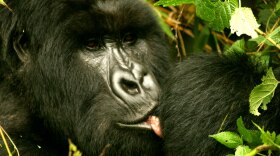When composer and traveling musician Ben Cosgrove was just 7 years old, he wrote a song called “Waves.” Since then, he’s made a career out of music inspired by landscape, place, and wilderness.
But if an artist has an environmental brand... do they also represent an environmental ethic?
Over the years, Ben began to wrestle with what his music was really saying about the natural world.
There is a lot of music about the outdoors, and our relationship to it. But it’s genres like classical, new age, and ambient that can sometimes feel authorless, as if the absence of vocals allow us to hear instrumental music as a representation of the natural world.
“I’ve always tried treating the rest of the world as a sort of writing prompt. Without using words or images, how can you suggest what this looks and feels like,” said Ben Cosgrove, a musician who started playing music when he was 4. Because he’s loved the outdoors as long as he has loved playing music, he has made a career out of representing place through song.
But over the years, as Cosgrove's career and music have developed, he started to question the kind of stories he’s telling. He started to feel troubled.
"I wasn’t necessarily saying things I didn’t believe. But I was ignoring most of the landscape by only focusing on the places that didn’t have people in them," Cosgrove said.
There are many songs about nature—songs that warn about pollution, like "Mercy, Mercy, Me" by Marvin Gaye or "Big Yellow Taxi" by Joni Mitchell. And there are songs about how we use nature from a practical perspective, like hunting and fishing.
What all these songs have in common though, is that they use lyrics to help shape their perspectives on nature for the listener. Cosgrove's music, on the other hand, is more enigmatic. If it weren’t for the title of the song and the image on the cover of the album, you probably couldn’t say for sure what inspired the music. But when you throw in a title that references nature, suddenly it might feel like the song is just transporting you into the outdoors, celebrating the beauty of the wild, and the pristine. Which, far from being simple observation, actually represents a certain environmental ethic.
“For a lot of my music, both in the way it was recorded and in the way I thought about it, I was writing about places thinking of myself as sort of like, you know, the Ralph Waldo Emerson ‘invisible eyeball’ thing?”

Emerson was a 19th century transcendentalist who, among other things, found divinity and spirituality in nature at a time when wilderness had historically been viewed by Europeans and American settlers as a place to be “tamed.” Its value was in its use, not its beauty. Emerson believed that nature was the closest thing to God. To be immersed within it—especially in solitude—is to witness, and become part of the divine.
“I become a transparent eyeball,” he wrote in his book Nature, along with an illustration of an eyeball with a hat and very long legs.
“I am nothing; I see all; the currents of the Universal Being circulate through me; I am part or parcel of God.”
There are plenty of historical reasons to learn about, or be interested in the ideas of Waldo Emerson. But taking inspiration from them? In retrospect, Cosgrove has decided that’s not really a good thing. And that’s partly because he’s recently been taking inspiration from a relatively more modern piece of writing.
"The Trouble with Wilderness," written by historian William Cronon, is an essay that was first published in 1995. It's been cited, assigned in classrooms, and debated by critics ever since. Cosgrove said that he's been recommending this essay to everyone around him.
“If there’s two or three things that have influenced my environmental philosophy I have, that’s No. 1 of them,” he said.
There are a few ideas laid out in Cronon's essay, but central to his essay is that it's problematic to believe in a dualistic separation between "wilderness" and "civilization." Cronon writes, “To the extent that we celebrate wilderness as the measure with which we judge civilization, we reproduce the dualism that sets humanity and nature at opposite poles. We thereby leave ourselves little hope of discovering what an ethical, sustainable, honorable human place in nature might actually look like.”
In the essay, Cronon lays this out in a historical context that outlines how our perceptions of wilderness—as represented by places like national parks and vast stretches of uninhabited landscape—were created through religious and colonial ideologies, often at the expense of indigenous people, and rural communities, that were violently displaced or oppressed in order to create them.
But how this all applies to Cosgrove’s music, or any music for that matter, is complicated.
“I slowly came to realize that people might be taking the wrong message away after hearing me sit on stage and tell stories about Isle Royal National Park for an hour,” Cosgrove said. “I wasn’t necessarily saying things I didn’t believe. But I was ignoring most of the landscape by only really focusing on places without people in them.”
So, over the last year, Cosgrove has been working to course correct his musical interpretation of the natural world. It’s a subtle shift, given the instrumental nature of his music, but a powerful one. He's written a whole new album about places where the built environment and the natural environment overlap and intersect.
“A lot of these songs are about weeds exploding through the sidewalk cracks. Highway supports getting grown over. Or gardens which are simultaneously ordered and explosive,” he said.
The title of the album, borrowed from William Cronon’s essay, is “The Trouble With Wilderness.” And it’s not just a break from his style, in terms of cover art and song titles. There are spots where, on the record, you can literally hear him breathing in the background.
“What we ended up doing was recording the mechanical guts of the piano very closely, so there’s all these microphones on hammers and strings on whippens, you can hear keys moving and my fingers going.”
Like Cronon, Cosgrove doesn’t want to give the impression that conservation is inherently bad, or that we shouldn’t protect habitat, or enjoy time spent in wilderness spaces. Instead, Ben’s shift is a subtle one—turning his gaze away from the mountains, and canyons, and forests, and yes, waves, and pointing it towards examples of nature that spring at his very feet.
"The Trouble with Wilderness" doesn’t argue for specific environmental policies, or describe a more ethical approach to conservation. It’s not a guide for how to save the planet, though perhaps such a guide would include something like it. But it can radically shift your perspective. And when the Trouble with Wilderness seeps in—the world stays exactly the same, but at the same time, everything looks different.
"The Trouble with Wilderness" changed the way Ben Cosgrove makes and thinks about his music. But what can it do to a hike? Or to a life? What do you lose, when your idea of wilderness evaporates? Maybe the better question is, what can you gain?








